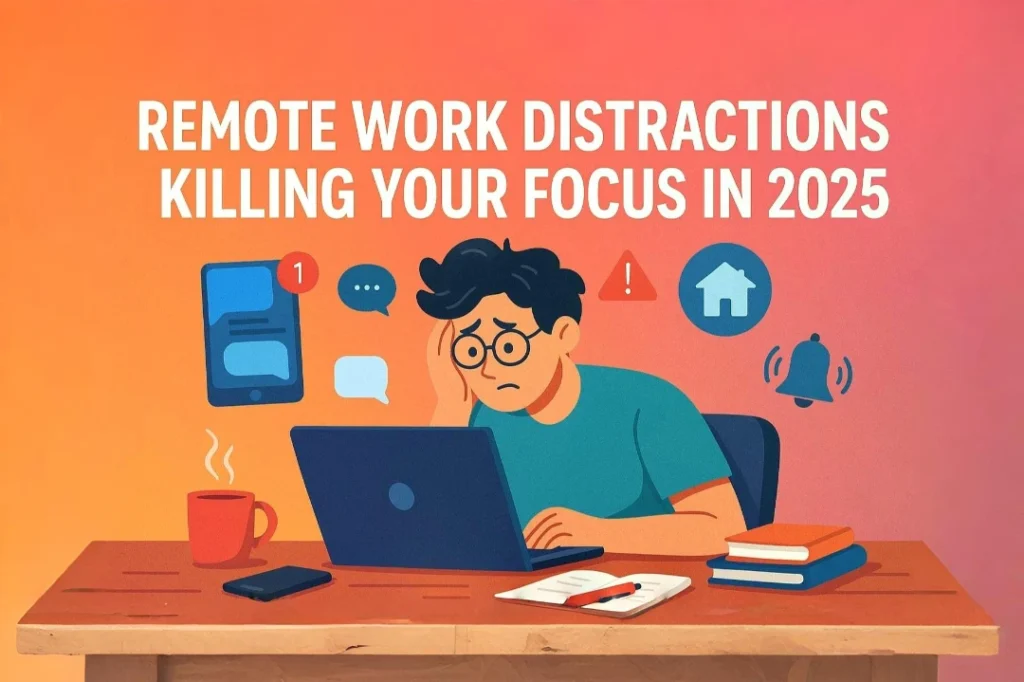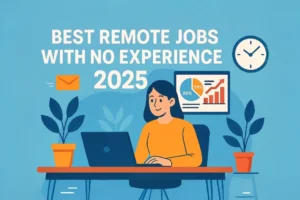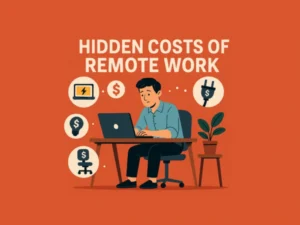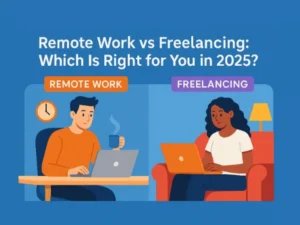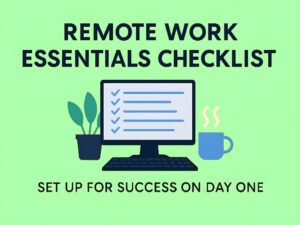Remote Work Distractions Killing Your Focus in 2025
Remote work distractions in 2025 are no longer just a minor annoyance—they’re one of the biggest dangers to your productivity, income, and mental concentration. With more business professionals embracing flexible workplace environments, the line between work and life becomes increasingly blurred. So every beep, pop-up, or casual home distraction may be costing you more than you know.
You may have the perfect tech stack or perfect home office setup, but if you do not work actively to manage distractions, your focus will suffer. This year, productivity isn’t about doing more work. It is about working smarter in an distracting, noisy, and interruptible world.
Here, in this article, we’ll expose the most common—and unsuspecting—distractions remote workers are facing in 2025, how they impact your productivity, and how you can get back your time, energy, and attention span. If you’re a freelancer, remote worker, or digital business owner, the information here will help you regain control over your workday and protect your focus from sneaky productivity assassins.
The Psychology Behind Distraction in Remote Work
In order to actually overcome remote work distractions, good to be familiar with why they happen at all. Working at home—or truly anywhere outside of a standard office—shifts the way our brains deal with attention and concentration. If you’re in an enclosed room like an office, your brain learns to expect that that will be a setting where you can focus. But outside of such environments, those internal messages aren’t as rigid, and that makes it easier to get sidetracked.
One of the worst offenders is context switching. Every time you switch from one task to read a notification or glance at your phone, your brain picks up and loses speed. Research shows it takes over 20 minutes to get back on task following an interruption. In a home environment where distractions are the norm—kids, pets, social media, background chatter—those minutes add up fast.
Another is the digital distraction dopamine loop. Emails, notifications, and even short browsers on your favorite app give the brain tiny rewards. These are harder and harder to resist, making it harder to sustain focus on deep work, which normally requires long stretches of concentrated attention. And in 2025, with still more AI-based platforms competing for your time, the fight is in the mind.
Understanding the psychological drivers that cause distraction is your first line of defense. After you know why your attention drifts, you can build better habits, put boundaries in place, and create an environment to do your best work—without always fighting the temptation to multitask.
Top Remote Work Distractions in 2025
Remote work distractions are changing in 2025. It’s more difficult than ever to stay focused with the proliferation of digital tools, changing lifestyles, and hybrid setups. The top five distractions listed below are ones that remote workers and freelancers must be aware of in order to remain profitable and productive.
1. Constant Notifications and App Overload
Between Slack, Zoom, email, and AI project tools, constant notifications are among the biggest remote work distractions. You might think you’re multitasking but in reality interrupting deep work. A RescueTime study says that most workers check communication software every 6 minutes on average. This disrupts focus and drains mental energy.
The solution? Turn off non-essential notifications, check your messages in batches, and block distractions using software like Freedom or Serene. AI productivity add-ons can also be employed that do routine tasks for you and enable you to focus—check out our freelancers ai extensions for inspiration.
2. Home Environment Triggers
Remote workers underestimate the potential for distraction in their surroundings. Laundry, dishes, family members, or even your pet wanting attention can all wear away your focus. Unlike a traditional office, your home lacks built-in productivity cues.
Setting aside a dedicated space, setting boundaries with the people you live with, and maintaining regular routines can go a long way to keeping interruptions to a minimum. For more setup tips, read our article on 2025 remote work setup essentials.
3. Social Media and News Addiction
TikTok browsing “just for a minute” turns into 30 minutes lost. Social media websites are engineered to make you hooked. In 2025, even AI-integrated news feeds are designed to be more appealing—i.e., more seductive distractions.
You can avoid getting into the scroll trap by removing social apps from your work devices, using browser blockers, and setting “no scroll” time blocks for sessions of deep work. For additional creative strategies for fewer screen temptations and how to amplify your earning power, check out our article on hidden money-making features inside apps you already use.
4. Meetings Without Boundaries
Zoom fatigue is still a thing in 2025. When every small conversation is a video call, it disrupts your flow and brings in mental noise. The majority of remote workers spend more time in meetings than actually producing real work.
To combat this, demand asynchronous updates where it makes sense. Use tools like Loom or Notion to forward quick video memos or project status. Constrain meetings to a specific reason and length, and never include: “Could this be a message instead?” These boundaries serve to regain control of your time and reduce mental fatigue from pointless calls.
5. Lack of Structured Breaks
Ironically, working without breaks is one of the most overlooked remote work distractions. Without a structured routine, it’s easy to overwork and burn out—or swing entirely to the other side and do nothing at all. Both lead to poor productivity and low energy levels.
Use methods like the Pomodoro technique to schedule intense work sessions followed by brief, conscious breaks. Step away from the monitor, stretch, or take a short walk to clear your mind. These mini-breaks might enable you to come back more concentrated and energized. If you’re working on several projects or juggling several clients, remaining mentally refreshed is important—our step-by-step guide on how to manage multiple clients as a freelancer has further practical tips.
How to Minimize Remote Work Distractions (Daily Systems and Habits)
Let’s face it, working remotely is fantastic until you lose focus due to a mountain of distractions. Working smarter, not harder, is the key to remaining productive in 2025. You can avoid common remote work distractions and create a more sustainable workflow by establishing daily routines and habits.
1. Start Your Day with a Distraction Audit
Before diving into tasks, take five minutes each morning to list potential distractions in your environment. Whether it’s your noisy neighbor, your habit of checking Reddit, or pending house chores — name them. Awareness is your first defense.
Apps like Toggl Track or RescueTime can show you where your time actually goes. It’s surprising how much gets eaten up by “quick checks” and unnecessary multitasking. Once you see the pattern, it becomes easier to fix.
2. Use a Time-Blocking Calendar
Time-blocking is one of the simplest and most effective habits to avoid remote work distractions. Instead of working from an open-ended to-do list, assign each task to a dedicated time block in your calendar. This adds structure and reduces decision fatigue.
Google Calendar is perfect for this, but for a smarter solution try Reclaim, it will automatically allocate time for your tasks and breaks based on priorities. You can also sync it with your task manager or use AI tools that optimize your schedule in real-time.
3. Create a “Focus Ritual” Before Work
Remote work has a tendency to make work and personal time bleed into each other. So, it helps to have a pre-work ritual that signals “it’s time to focus.” It could be as straightforward as making coffee, opening your planner, or turning on the same focus playlist.
Doing the same small routine every morning cues your brain that it’s time to be in work mode. For many freelancers, this works better than just sitting down and trying to get into flow. It’s especially helpful if you’re working at home and need that extra psychological boundary.
4. Use One App for Deep Work Sessions
Freelancers are spoiled for tools in 2025, but that can lead to tool fatigue. For your deep work sessions, pick a single app or methodology. Whether it’s Notion, Trello, or even a basic timer, use it for concentrated time blocks.
Block switching between apps, windows, or browser tabs. If you prefer a minimalistic productivity experience, utilize Cold Turkey or Brain.fm for distraction-free sessions. This is also handy if you’re scaling your freelance business and need big blocks of uninterrupted creative time. Check out our ultimate guide on how to scale your freelance business without burnout.
5. Use Micro-Breaks with Movement
Spending hours in front of a screen does not equate to being productive. It simply tires your brain. Micro-breaks — as short as 2 to 3 minutes — can recharge your energy and make your focus keener. The trick is to physically move your body.
Do some stretching, go water your plants, or walk the room. Tools like Stand Up! provide reminders to take movement breaks throughout the day. In the long run, this averts exhaustion and boosts mental concentration, especially in handling a volume of tasks or clients.
How AI and Tools Can Help Eliminate Distractions
Even with optimal day-to-day habits, remote distractions can still creep in — that’s where intelligent tools are necessary. In 2025, artificial intelligence-driven apps and digital assistants become vital to assist freelancers in cutting through distractions, getting tasks done, and regaining focus.
1. Leverage AI to Prioritize and Schedule Your Workday
Computer programs like Motion or Reclaim automate your day through deadlines, task priority, and work routine. They act as intelligent assistants that reschedule low-priority tasks with time for time of deep focus.
By blocking time in advance with AI, you avoid context-switching and save time taken in deciding what you need to do next. You feel like you have your own productivity coach that keeps your day optimal without micromanaging you.
2. Try Browser Extensions That Keep You Focused
If your distractions are within your own browser (e.g., YouTube rabbit holes or checking the news constantly), you can experiment with extensions like Limitless or Focus To-Do. They politely remind you where your priorities lie by tracking time on every site and enabling you to set healthy boundaries.
They also give you visual feedback — to realize that you spent 2 hours on social media without even being aware is usually sufficient to make tomorrow better.
3. Make use of Noise Cancellation Tools for Focus Time
Background noise is subtle productivity poison. If you work in a noisy household or shared space, use AI tools like Krisp or NVIDIA RTX Voice to eliminate background noise during calls or focus sessions. You can use them in combination with focus music apps or noise makers to build your own customized sound bubble.
In the age where remote workers are constantly multitasking, reducing audio noise can be one of the easiest wins.
4. Auto-sume Your Meetings
Meetings are not necessarily preventable, but they do not have to take up your whole afternoon. Software like TL;DV and Fireflies.ai have the ability to automatically record, transcribe, and summarize meetings — allowing you to skip non-critical meetings or just hear the highlights.
This minimizes meeting fatigue and stops you from having to change gears too frequently throughout the day.
5. Use Smart Email Filters to Empty Your Inbox
Inbox clutter is another modern distraction. AI-driven email applications like Superhuman or Gmail’s Priority Inbox let you filter through email automatically based on relevance. Some even let you “pause” incoming messages during periods of deep work.
The less you respond to email bings, the more proactive you can be in your client or creative work.
The Cost of Distraction: Productivity and Income Loss
Remote work distractions are harmless in the moment — a quick glance at your phone, a spontaneous chat, or just “checking email” one last time. They add up, however, and steal away from both your productivity and your potential earnings over time. In 2025, being aware of the subtle cost of distraction will be the key to keeping remote work viable and lucrative.
1. The Time That You Don’t Know You’re Losing
It takes 23 minutes for the average person to refocus after a distraction, studies have found. If you multiply that by several interruptions a day, you’re looking at hours of lost deep work every single week. That’s time you might have spent delivering client projects, selling new business, or building your own brand.
Applications like RescueTime and Clockify can help reconcile the actual amount of time that is being lost. With this information at your fingertips, you will be surprised at how much your productivity is being robbed by small, seemingly innocent lapses of focus.
2. Lost Deadlines and Client Trust
If you keep getting sidetracked away from your job, deadlines start slipping. That isn’t a major problem one or two times, but it definitely is over time. Freelancers who are chronic deadlineuers risk destroying their reputation and losing long-term customers.
Remote work distractions can erode the pace you need to stay in front of deliverables. And when trust is lost, so is your compensation. Clients may be less willing to send you new work or choose faster, more reliable freelancers in preference to you.
3. The Pay Consequence of Diminished Output
The connection between productivity and income is strongest for freelancers. The fewer finished projects, the fewer billable hours or deliverables — which has a more direct effect on your income. When you’re billing on a per-project basis, slowing down to finish jobs essentially lowers your hourly wage.
Consider this: losing one billable hour a day to interruption can cost you over $500 per month (with a $25/hour billing rate). That’s a year of $6,000 lost. Do that math for the number of clients you have and it’s even larger.
4. Burnout from Unfinished Work
Ironically, distractions do not automatically result in more sleep. They will result instead in incomplete work brought home with you into the evening or weekend. That constant backlog creates mental stress, leading to pressure and eventually burnout.
Remote workers who are bad at coping with distractions will “work all the time” but not actually get much done. This blurring of work and personal life affects mental health, as well as reducing your overall long-term output.
5. Why Reducing Remote Work Distractions Pays Off
By cutting down Remote work distractions, you’re not just boosting productivity — you’re protecting your income and your professional reputation. Building better focus habits could be the difference between working all night and missing a deadline and delivering high-quality work on time consistently.
If your aim is to expand as a remote professional or freelancer in 2025, distraction management must be addressed as a business ability. It’s not a matter of being busy, it’s about remaining profitable.
Conclusion + Action Steps
Remote work distractions are no longer a pesky sideshow. As of 2025, they’re an immediate threat to your productivity, your mental focus, and your paycheck.
Whatever the form – as noisy notifications, disorganized meetings, or the endless siren call of social media – these distractions can undermine the quality of your work and the integrity of your remote or freelance career.
The bad news? You’re not alone. The good news? You’re not powerless. By accessing the psychological forces behind distraction and bringing up doable strategies — from designing a concentration-friendly environment to making the most of time-blocking strategies and savvy digital tools — you can take back your day. That is, more done, more money, and less stress.
Action Steps You Can Take Today:
- Audit your internet behavior: Use software like Freedom or StayFocusd to find your biggest time wasters.
- Schedule unbreakable focus sessions: Put distraction-free blocks in your calendar every day. Treat them like high-priority meetings with yourself.
- Remove digital clutter: Switch off distracting notifications, close off unnecessary browser tabs, and remove distracting programs from primary work machines.
- Set your limits: Let your clients or coworkers know when you are fully engaged in work and when you are able to have a speedy sync.
- Establish a reset habit: Develop a speedy routine that refocuses you when you’re scattered — even five minutes of slow breathing or a brief walk.
These are baby steps, maybe, but collectively they add up to a workday that is working for you, not against you. With as little distraction as possible, you’ll get more momentum and will be better placed to stay consistent.
To take it a step further, don’t miss Digital Declutter for Freelancers: Reset Your Focus in 2025. It walks you through how to reset your work environment, mindset, and tools to cut distractions at the source.
You might also want to explore how your personal brand as a freelancer can impact your ability to attract serious, high-value clients who respect your focus time.
And don’t miss the new guide, The Hidden Costs of Remote Work in 2025, where we reveal how distractions are not only stealing your time, but quietly draining your wallet.
Most importantly, don’t read — do. Your focus is your most valuable asset in a world that is becoming remote-first. Start reigning in remote work distractions now, and watch your productivity and profits soar.

